Environmental and Health Concerns: Routes of Exposure
Possible routes of exposure:
Inhalation: Inhalation is the most common route of exposure to airborne particles in the workplace. Due to their size, nanoparticles appear to penetrate deep into the lungs and may translocate to other organs. (NIOSH, 2012)
Skin Absorption: Dermal exposure to nanomaterials is also a potential exposure route. Possible harmful effects may occur locally, or substances may be absorbed through the skin and cause a systemic effect. (NIOSH, 2012)
Ingestion exposure: Ingestion of nanomaterials might occur due to unintentional hand-to-mouth contact, thereby allowing possible transfer to other organs via gastrointestinal tract. The mucciliary escalator system, where particles are deposited in the lung are transferred by coughing to the pharynx and subsequently swallowed, is an additional path to ingestion (NIOSH, 2012)
Injection: Exposure by accidental injection (skin puncture) is also a potential route of exposure, especially when working with needles during preparation. administration, and disposal of medication containing nanoparticles.
Toolbox
- Yildirimer, L., Thanh, N. T. K., Loizidou, M., & Seifalian, A. M. (2011)., Toxicology and clinical potential of nanoparticles. Nano Today, 6(6), 585–607. http://doi.org/10.1016/j.nantod.2011.10.001
- https://www.cdc.gov/niosh/docs/2012-147/pdfs/2012-147.pdf
